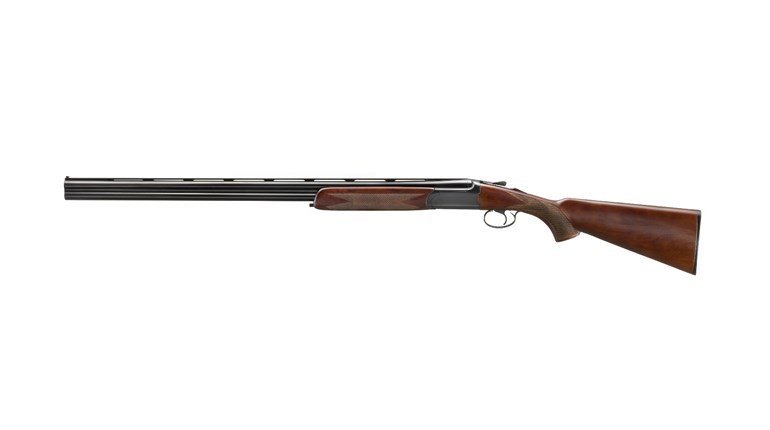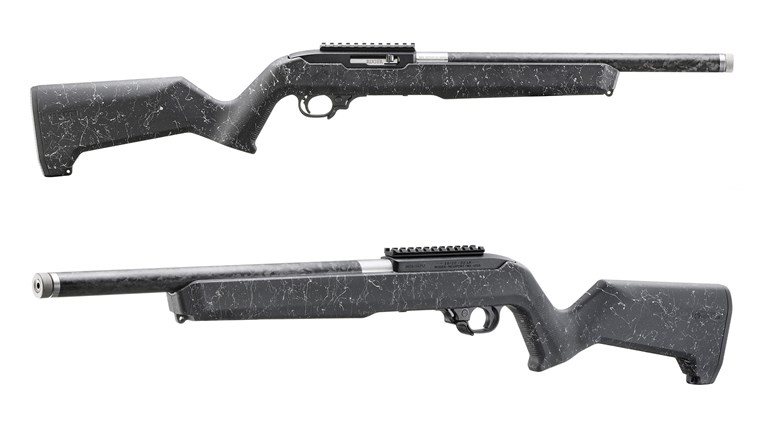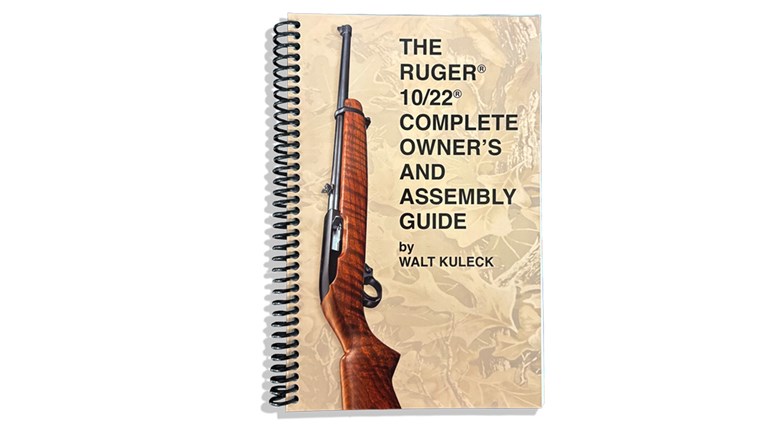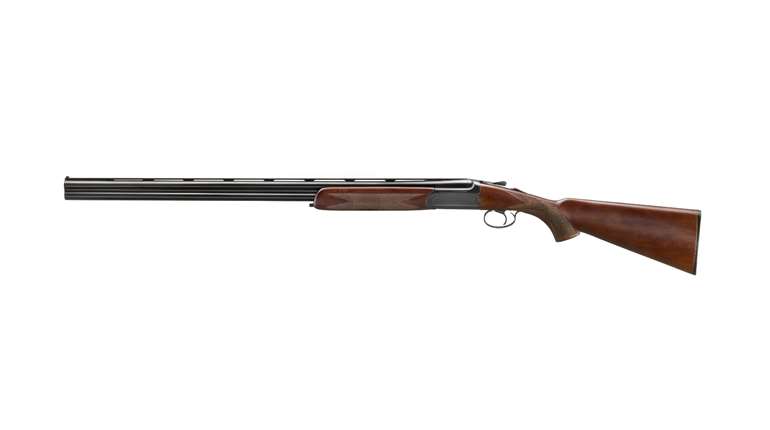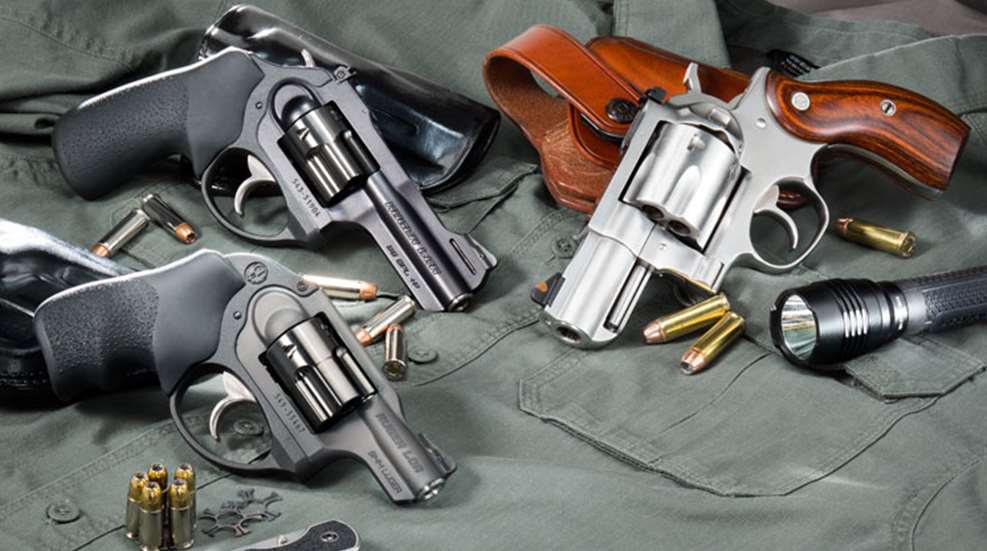
Ruger’s light compact revolvers (LCRs) are having a big impact on the concealed-carry and defensive-handgun market. Besides being lightweight and compact, these polymer wheelguns are affordable and have excellent double-action trigger pulls right out of the box. Different models offer interesting and useful variations, as in hammerless or with an external hammer, chamberings in centerfire or rimfire cartridges or with different sight options. Two of the company’s latest revolvers are in the LCR line, but offer new options. One (chambered in .38 Spl.) has a 3-inch barrel, an exposed hammer and adjustable sights, while the other is chambered in 9 mm, has an internal hammer and a standard, 2-inch barrel.
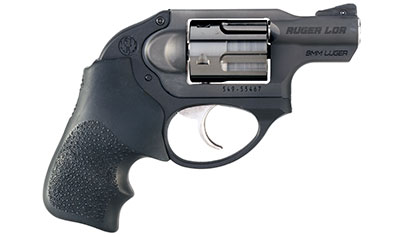
Ruger’s third new revolver is definitely not in the LCR category, and many readers might instantly dismiss it from consideration as a carry gun. I even had a brief argument with my editor about including it in this piece. I’m referring to Ruger’s new Redhawk with a 2.75-inch barrel and chambered in .44 Mag. Is it a pocket pistol? No, but it is an authoritative and concealable big-bore carry gun for your belt.
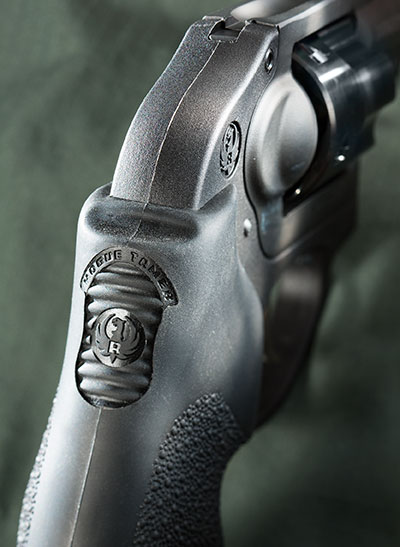
A pocket revolver in 9 mm actually makes a lot of sense. It allows you to have a backup gun chambered for the same ammo used in your primary or duty pistol. Interchangeable ammo is an excellent concept that can greatly simplify your logistics, whether for concealed carry or home defense. And while you might not actually carry a backup gun on your person, having one in the home or car makes sense under the “One is none, two is one” rule.
Ruger’s new LCR in 9 mm is a classic pocket revolver (apart from its modern, polymer frame) with its 2-inch barrel, five-shot cylinder and double-action-only, hammerless configuration. That said, with a trigger-guard shape slightly different from other manufacturers’ five-shot revolvers, the LCR 9 mm may require a different pocket holster. Hard leather holsters, particularly custom rigs fitted to Smith & Wesson J-frames, won’t fit this new 9 mm. I found one soft, synthetic holster from Tuff Products and one soft, rough-side-out leather pocket holster from Galco that fit well. If you decide to carry the little revolver in an OWB rig, Galco’s Stinger belt holster is available specifically for 2-inch Ruger LCRs and is quite comfortable over long periods.
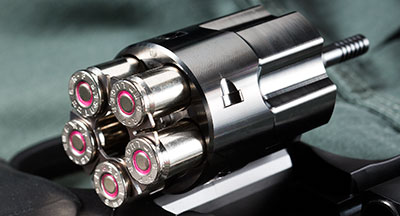
As I’m sure you know, firing a rimless cartridge in a double-action revolver generally requires the use of some kind of “moon” clip to create an artificial rim against which the extractor can push to eject fired cases. In the old six-shot .45 ACP revolvers, these can be half-moon clips holding three rounds each, six-shot full-moon clips or two-shot (one-third moon?) clips. Since five is an odd number, a five-shot moon clip is required for the gun, and Ruger offers them in the proper size. In the past, I’ve had some difficulty loading individual rounds into full-moon clips and great difficulty removing empty brass. Ruger has thoughtfully cut long slots in its moon clips between each round, creating some flexibility and making round insertion and case removal much simpler. I did not need a mooning/de-mooning tool to accomplish the task.
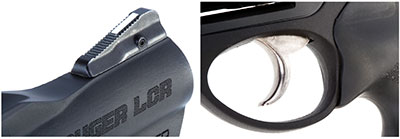
Though I had expected to see a larger gap between the breechface and the rear of the cylinder to accommodate the extra thickness of the moon clip, this turned out not to be needed. Ruger extended the circumference of the recess cut in the cylinder face, so the moon clip is fully enclosed in the cylinder, with only the 9 mm case “rims” extending beyond the cylinder’s face. It’s difficult to spot the difference between the .38 Spl. and 9 mm frames when the guns are either loaded or empty. The extractor teeth are thinner and less beefy on the 9 mm than on the .38 Spl., but it didn’t seem to make a difference when firing the little guns.
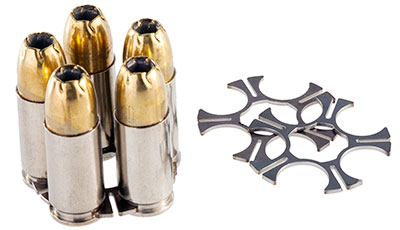
Front sights on both the LCR 9 mm and the LCRx 3-inch are serrated ramps with a thin white stripe slightly narrower than the ramp itself. This is a reasonable compromise, offering a standard black sight picture during daylight engagements and the enhanced visibility of the white stripe in low light. The front sight is pinned, so a gunsmith should be able to install a different front sight if you prefer. It is uncertain whether Ruger plans to offer other front sight options in the future.
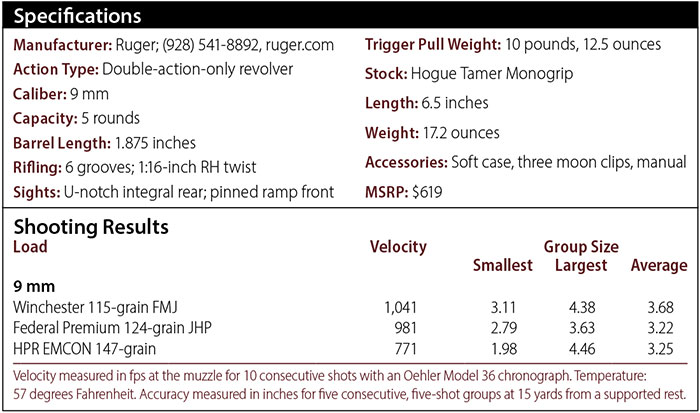
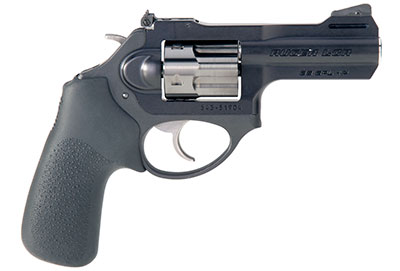
The rear sight on the 9 mm is a square notch cut into the frame’s topstrap, while the LCRx 3-inch in .38 Spl. has an adjustable sight recessed into a thicker topstrap. It, too, is a square notch, so sight pictures are basically the same for both guns. With reading glasses or my prescription shooting glasses, I could acquire a good, conventional sight picture with both revolvers—without glasses, I could still see the white front-sight stripe and put it on target with ease.
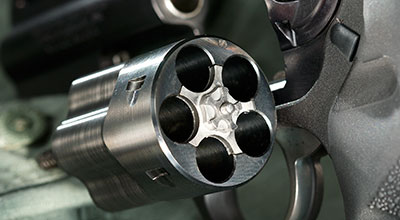
Grips on both guns are a synthetic material with a stippled effect on the sides that offers solid purchase. A soft material high on the backstrap lessens felt recoil against the thumb joint and the web of the hand. On the more concealable 9 mm, the grips are rather short and include two finger grooves. The 3-inch LCRx has grips with no grooves that are longer to accommodate all fingers of the firing hand. Depending on loads fired, recoil is snappier on the 9 mm than on the .38 Spl., even when the latter is loaded with +P rounds. That’s a price you pay when you decrease the size of a cartridge case and try to increase the performance. Recoil isn’t painful, but it may pose problems in maintaining control of the gun during rapid or semi-rapid firing, particularly where the pinky finger of the shooting hand is not part of your grip. Newer shooters or those more sensitive to recoil might want to avoid 9 mm+P loads and stay with lighter bullets designed for rapid expansion/self-defense.
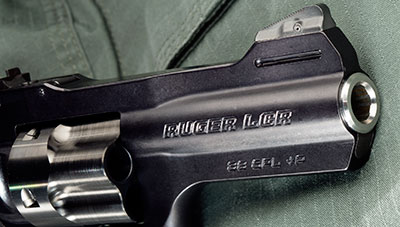
Loading and reloading procedures are quite different for the two guns. With the moon clip, the five rounds of rimless 9 mm ammo are loaded and ejected as a single unit, always held together by the clip. The rimmed .38 Spl. rounds can be loaded and ejected simultaneously or individually, since speedloaders separate from the ammo once the rounds are inserted into the chambers. This means there are no partial or tactical reloads with the 9 mm, whereas the 3-inch LCRx can be “topped off” with a couple of rounds during any lull in the fight. You can replace a partially used 9 mm moon clip with a fresh five rounds if you’re concerned about remaining capacity, but it’s unlikely you’ll be able to reinsert any retained moon clip holding both empty cases and live rounds. Realistically, though, most trainers suspect in an actual fight, it’s most likely any five-round revolver will be run dry before attempting a reload.
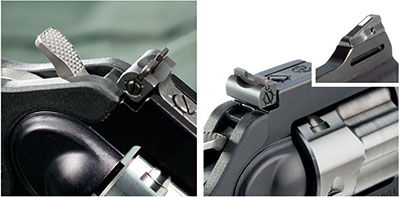
Though most people will recognize the value of a big-bore revolver as a trail gun, a lot of folks will disagree with my categorizing Ruger’s new Redhawk in .44 Mag. as a potential carry gun. Even with its short, 2.75-inch barrel, many will find it far too big and heavy to be carried concealed. Some might even say I’m having an Austin Powers 40-year time trip back to the original “Dirty Harry” movie, where Clint Eastwood carried a 6.5-inch-barreled .44 Mag. in a shoulder holster under his sport coat. Yes, at a bit less than 3 pounds, the Redhawk is heavy, but I’ve carried .44 Mags. in a belt holster for days at a time on hunting trips with the additional weight of a hunting pack and not been uncomfortable with the weight. Admittedly, as I get older the packs are getting much lighter and the distances traveled are growing shorter, but I still carry big-bore revolvers with relative comfort.
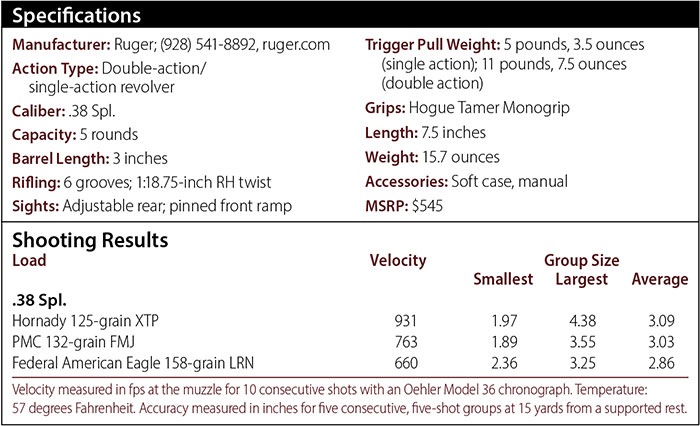
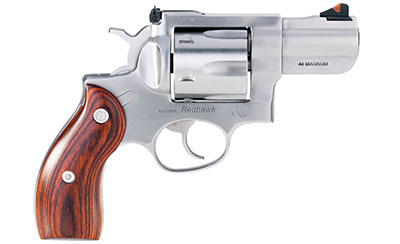
With its 2.75-inch barrel, the Redhawk has slightly more length to hide than the Ruger 9 mm LCR and slightly less than the 3-inch-barreled LCRx in .38 Spl. When you combine the Redhawk’s barrel and cylinder length, you’re dealing with a gun slightly shorter than a standard size 1911, and that’s certainly a popular carry pistol. This big-bore wheelgun simply needs a loose, untucked outer garment for concealment. But it’s the Redhawk’s performance potential that suggests it be considered as a suitable defensive-carry gun.
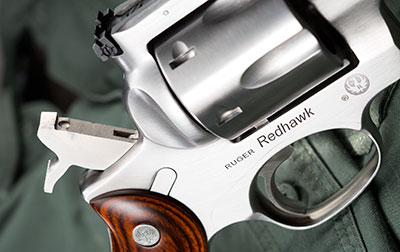
From the short barrel, the .44 Spl. loses a lot of velocity, but should still be an adequate fight-stopper. The Redhawk’s small stock is still big enough for a solid firing grip, but small enough for shooters with smaller hands to still run the gun without difficulty. Should you want more power or penetration, Buffalo Bore, Cor-Bon and DoubleTap offer higher-velocity .44 Spl. ammo with jacketed hollow points or heavyweight hard-cast bullets. Finally, if you’re in a rural area and want to turn a bad guy’s cover into concealment, Garret Cartridges of Texas offers a .44 Mag. load topped with a 310-grain, hard-cast, lead bullet that generates slightly less than 1,000 fps.
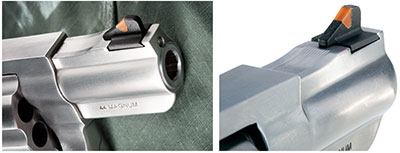
When a group of writers gathered at Ruger to fire a pre-production model of the compact Redhawk, the only person tough enough to shoot more than a cylinder of full-power, 240-grain .44 Mag. factory ammo was a strapping young Border Patrol agent. While I immediately liked the gun, my “happy quotient” was fully satisfied after six rounds of the heavy ammo. If you want to flatten the trajectory with higher velocity, you might look at lighter, 180-grain bullets and determine the velocity where your tolerance for recoil is reached. Given the Redhawk’s short sight radius and limited range, I’d be looking at maximizing power with heavier bullets at lower velocities inside of 50 yards.
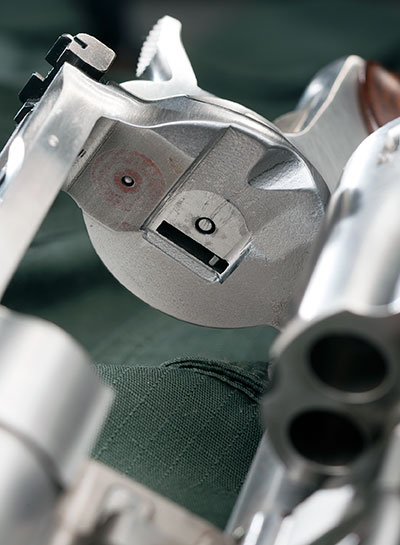
The Redhawk is a handsome hunk of stainless steel. Surfaces that interface with the hand are, for the most part, nicely rounded (or dehorned, if you prefer) to remove any sharp edges. Still, you may wish to consider some lightly padded gloves to minimize the impact of recoil and extend your shooting sessions. During the brief time I was able to wear the gun in a Galco DAO holster, weight and comfort were not concerns, but I did find myself bumping the gun whenever I sat in a chair with arms. Although a baggy, untucked garment easily hid both holster and gun, I wasn’t accustomed to the bulk of the Redhawk’s large cylinder. The holster’s retention strap was also appreciated for this densely packed handgun. I’d be very reluctant to use a Jak-slide type of holster, where a hard push on the exposed barrel could expel the Redhawk out of the leather and leave it laying on the floor for the world to see.
The Redhawk’s rear sight is fully adjustable, with a white outline surrounding the notch. The front sight has a red, plastic insert for enhanced visibility and is mounted in a slot cut into the heavy rib on top of the barrel. It can be replaced by another front sight simply by pushing the spring-loaded pin and lifting the sight off. The red plastic insert is nicely visible against a dark background, so long as there is adequate ambient light shining on the blade. It becomes dramatically less visible as light diminishes. While my aging eyes have become a fan of Hamilton Bowen’s Redhawk front sight with its white stripe, the factory red insert is quite serviceable.
Since both the Redhawk and the LCRx 3-inch have exposed hammers, they can be fired in both single-action and double-action modes. On the Redhawk, the double-action pull is smoother than expected, while the single-action pull is heavier than anticipated, which is par for the course with other wheelguns in the line. This is not an issue for a carry gun, since the powerful revolver’s primary mission will be self-defense, requiring quick and decisive action up close and personal. However, should a precision shot be required out past 20 or 30 yards, the gun is ready and capable. Despite its size, or perhaps because of its size and power levels, the Redhawk can expand your defensive options beyond the capabilities provided by other handguns, while staying within the dimensions and parameters of a concealed-carry pistol.
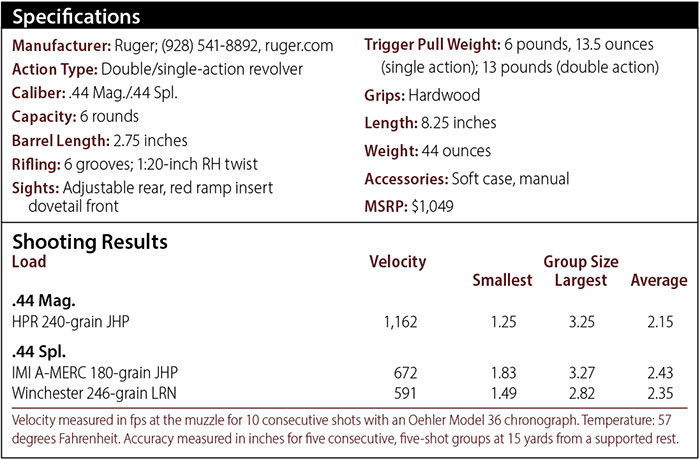
I would be comfortable carrying any of these three revolvers as a defensive firearm. The 2-inch LCR 9 mm is an excellent choice for backup gun for anyone carrying a 9 mm semi-automatic, but it can also stand alone on those occasions where one’s only concealment option is a pocket. I’d carry it in a Tuff Product’s Size 10 soft holster that fits nicely in just about any pocket. The LCRx 3-inch in .38 Spl. raises the bar a bit on both size and performance. Though slightly larger than I like for a pocket pistol, the longer barrel and adjustable sights extend its range and make it more comfortable to shoot. It could be carried in an IWB holster or as a backup gun in an ankle holster.
Like a diamondback’s rattle or a brown bear’s growl, nothing in the handgun world says “Beware!” like a .44 Mag. Given today’s ammunition in this caliber (including .44 Spl.,) there are few missions it can’t perform, except hiding in your pocket. Ruger’s Redhawk is virtually indestructible, and its performance potential far exceeds that of other carry handguns. Pick the ammo you can handle and venture forth bravely.
No matter which revolver you choose, wheelguns remain a viable choice for self-defense.












